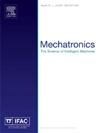在密闭环境中通过鲁棒雅各布估计实现腱鞘驱动连续机器人的最佳视觉控制
IF 3.1
3区 计算机科学
Q2 AUTOMATION & CONTROL SYSTEMS
引用次数: 0
摘要
由于需要精确的运动学模型,而该模型容易受到外部干扰,因此在密闭环境中对连续机器人进行精确控制是一项重大挑战。本文介绍了一种无模型最优视觉控制(MLOVC)方法,该方法可使腱鞘驱动连续机器人(TSDCR)在密闭环境中有效跟踪视觉目标,同时确保稳定性。该方法允许 TSDCR 沿着狭窄的管腔进行管腔内导航。为了考虑外部异常值的存在,我们提出了一种稳健的雅各布估计方法,其中使用了改进的迭代重加权最小二乘法和滑动窗口,以便根据传感数据在线计算机器人的雅各布矩阵。估计的雅各布矩阵建立了视觉特征与执行之间的运动关系。此外,还设计了一种基于二次编程(QP)的最佳视觉控制方法,用于视觉目标跟踪,同时考虑机器人的物理约束和控制约束。用于视觉跟踪的 MLOVC 方法提供了一种可靠的替代方法,它不依赖于 TSDCR 的精确运动学,并考虑了异常值的影响。通过 Lyapunov 分析,证明了所提方法的控制稳定性。通过模拟和实验评估了 MLOVC 方法的有效性,结果表明该方法在精度和稳定性方面提高了跟踪性能。本文章由计算机程序翻译,如有差异,请以英文原文为准。
Optimal visual control of tendon-sheath-driven continuum robots with robust Jacobian estimation in confined environments
Accurate control of continuum robots in confined environments presents a significant challenge due to the need for a precise kinematic model, which is susceptible to external interference. This paper introduces a model-less optimal visual control (MLOVC) method that enables a tendon-sheath-driven continuum robot (TSDCR) to effectively track visual targets in a confined environment while ensuring stability. The method allows for intraluminal navigation of TSDCRs along narrow lumens. To account for the presence of external outliers, a robust Jacobian estimation method is proposed, wherein improved iterative reweighted least squares with sliding windows are used to online calculate the robot’s Jacobian matrix from sensing data. The estimated Jacobian establishes the motion relationship between the visual feature and the actuation. Furthermore, an optimal visual control method based on quadratic programming (QP) is designed for visual target tracking, while considering the robot’s physical constraint and control constraints. The MLOVC method for visual tracking provides a reliable alternative that does not rely on the precise kinematics of TSDCRs and takes into consideration the impact of outliers. The control stability of the proposed approach is demonstrated through Lyapunov analysis. Simulations and experiments are conducted to evaluate the effectiveness of the MLOVC method, and the results demonstrate that it enhances tracking performance in terms of accuracy and stability.
求助全文
通过发布文献求助,成功后即可免费获取论文全文。
去求助
来源期刊

Mechatronics
工程技术-工程:电子与电气
CiteScore
5.90
自引率
9.10%
发文量
0
审稿时长
109 days
期刊介绍:
Mechatronics is the synergistic combination of precision mechanical engineering, electronic control and systems thinking in the design of products and manufacturing processes. It relates to the design of systems, devices and products aimed at achieving an optimal balance between basic mechanical structure and its overall control. The purpose of this journal is to provide rapid publication of topical papers featuring practical developments in mechatronics. It will cover a wide range of application areas including consumer product design, instrumentation, manufacturing methods, computer integration and process and device control, and will attract a readership from across the industrial and academic research spectrum. Particular importance will be attached to aspects of innovation in mechatronics design philosophy which illustrate the benefits obtainable by an a priori integration of functionality with embedded microprocessor control. A major item will be the design of machines, devices and systems possessing a degree of computer based intelligence. The journal seeks to publish research progress in this field with an emphasis on the applied rather than the theoretical. It will also serve the dual role of bringing greater recognition to this important area of engineering.
 求助内容:
求助内容: 应助结果提醒方式:
应助结果提醒方式:


